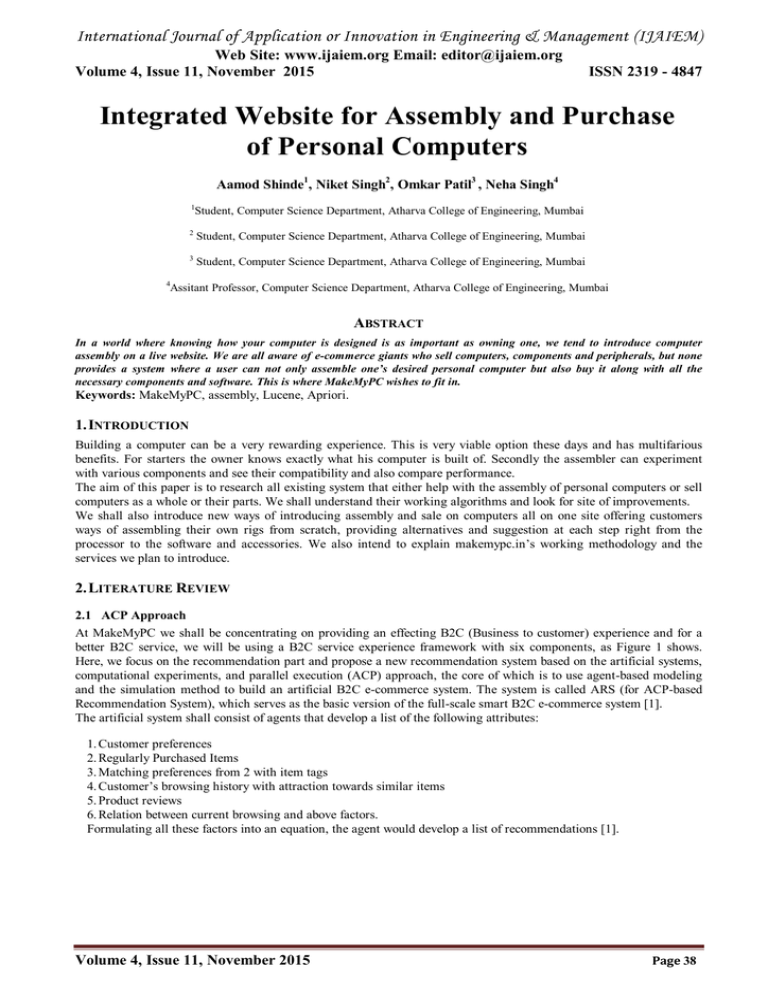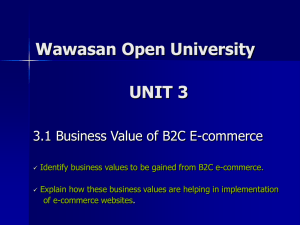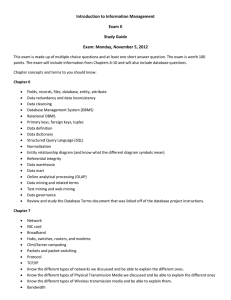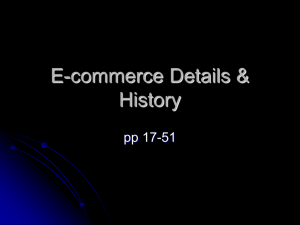Integrated Website for Assembly and Purchase of Personal Computers
advertisement

International Journal of Application or Innovation in Engineering & Management (IJAIEM) Web Site: www.ijaiem.org Email: editor@ijaiem.org Volume 4, Issue 11, November 2015 ISSN 2319 - 4847 Integrated Website for Assembly and Purchase of Personal Computers Aamod Shinde1, Niket Singh2, Omkar Patil3 , Neha Singh4 1 Student, Computer Science Department, Atharva College of Engineering, Mumbai 2 Student, Computer Science Department, Atharva College of Engineering, Mumbai 3 Student, Computer Science Department, Atharva College of Engineering, Mumbai 4 Assitant Professor, Computer Science Department, Atharva College of Engineering, Mumbai ABSTRACT In a world where knowing how your computer is designed is as important as owning one, we tend to introduce computer assembly on a live website. We are all aware of e-commerce giants who sell computers, components and peripherals, but none provides a system where a user can not only assemble one’s desired personal computer but also buy it along with all the necessary components and software. This is where MakeMyPC wishes to fit in. Keywords: MakeMyPC, assembly, Lucene, Apriori. 1. INTRODUCTION Building a computer can be a very rewarding experience. This is very viable option these days and has multifarious benefits. For starters the owner knows exactly what his computer is built of. Secondly the assembler can experiment with various components and see their compatibility and also compare performance. The aim of this paper is to research all existing system that either help with the assembly of personal computers or sell computers as a whole or their parts. We shall understand their working algorithms and look for site of improvements. We shall also introduce new ways of introducing assembly and sale on computers all on one site offering customers ways of assembling their own rigs from scratch, providing alternatives and suggestion at each step right from the processor to the software and accessories. We also intend to explain makemypc.in’s working methodology and the services we plan to introduce. 2. LITERATURE REVIEW 2.1 ACP Approach At MakeMyPC we shall be concentrating on providing an effecting B2C (Business to customer) experience and for a better B2C service, we will be using a B2C service experience framework with six components, as Figure 1 shows. Here, we focus on the recommendation part and propose a new recommendation system based on the artificial systems, computational experiments, and parallel execution (ACP) approach, the core of which is to use agent-based modeling and the simulation method to build an artificial B2C e-commerce system. The system is called ARS (for ACP-based Recommendation System), which serves as the basic version of the full-scale smart B2C e-commerce system [1]. The artificial system shall consist of agents that develop a list of the following attributes: 1. Customer preferences 2. Regularly Purchased Items 3. Matching preferences from 2 with item tags 4. Customer’s browsing history with attraction towards similar items 5. Product reviews 6. Relation between current browsing and above factors. Formulating all these factors into an equation, the agent would develop a list of recommendations [1]. Volume 4, Issue 11, November 2015 Page 38 International Journal of Application or Innovation in Engineering & Management (IJAIEM) Web Site: www.ijaiem.org Email: editor@ijaiem.org Volume 4, Issue 11, November 2015 ISSN 2319 - 4847 Figure 1 Six Components of B2C Experience Framework [1] 2.2 Search Engines and Algorithms 2.2.1 Lucene Search Engine Lucene is one of Apache’s software projects which is an open source full text search engine toolkit. It isn’t really a full text search engine, but a full-text search engine framework that can provide users complete query engine, text indexing engine and part of the analysis engine, it can also provide a simple but powerful API interface so that people can conveniently and quickly develop the search engine [2]. Apache’s Lucene provides API (Application Program Interface) to index documents as well to query the index and fetch documents that match the query. Indexing is the method of storing text data in index files in a format that helps in fast and efficient text searching. Lucene stores the text data in a data structure called inverted index which can be stored in the file system or memory. The text data is analyzed prior to storing it in the index files [2]. 2.2.2 Apriori Association rule mining is considered to be the most important technique in the field of data mining. Association rule mining is the efficient method which is used in finding the association rules. These association rules describe the associations between the attribute values of any item set. They can be found by means of various methods among which support and confidence will be considered as the optimized methods in finding them [3]. The Apriori Algorithm is one of the algorithms that makes use of association mining. Apriori uses a breadth-first search strategy to count the support of item sets and uses a candidate generation function which exploits the downward closure property of support. Apriori uses pruning techniques to avoid measuring certain item sets, while guaranteeing completeness [3]. The Apriori algorithm takes advantage of the fact that any subset of a frequent item set is also a frequent item set. The algorithm can therefore, reduce the number of candidates being considered by only exploring the item sets whose support count is greater than the minimum support count. All infrequent item sets can be pruned if it has an infrequent subset. In the process of finding frequent item sets, Apriori avoids the effort wastage of counting the candidate item sets that are known to be infrequent. The candidates are generated by joining among the frequent item sets level wise, also candidate are pruned according the Apriori property [3]. 2.3 Payment Gateways An E-Commerce website without a payment gateway would just be left with the ‘E’ from E-Commerce. The necessity of a payment gateway arises from the point of view of including online transactions on the website. A payment gateway, to understand, is any e-commerce application service provider authorizes credit or debit cards payments for online businesses, or e-commerce to stick to our context. The gateway primarily facilitates the transfer of data between a payment portal and the Front End processor or the acquiring bank [4]. 3. EXISTING SYSTEMS From stores that help assemble computers and sell products, to websites with online assembling assistance and those that sell pre-configured personal computers, laptops and computer components we shall study their working and functions. Volume 4, Issue 11, November 2015 Page 39 International Journal of Application or Innovation in Engineering & Management (IJAIEM) Web Site: www.ijaiem.org Email: editor@ijaiem.org Volume 4, Issue 11, November 2015 ISSN 2319 - 4847 3.1 Physical Computer Stores Retail stores with assembly assistance and those that sell products are a common site. These stores provide customers with a wide range of products and options usually depend on their availability. 3.2 Websites that Sell Computers and Components Online E-commerce giants like Amazon, Flipkart and Snapdeal sell pre-configured computers and laptops as well computer components, peripherals, accessories and software too. But all these components are hidden deep within layers of fashion products, household appliances and a huge illusion of offers being provided on them. On the other hand these websites do not have integrated in them any sort of assembly method or compatibility algorithms. So even if a user succeeds at assembling an entire computer online with one’s own knowledge, it would be hard to predict the compatibility of these components with each other AND with the software we intend to run on it. It thus becomes a very dodgy situation and the customer ends up choosing a pre-configured company branded computer which not hits his pocket but also limits the applications. These websites are built upon state of the art database systems and have incredible search algorithms and filter options. Flipkart, for instance, makes use of Apache’s Lucene framework for searching methods; which we would use as well. 3.3 Websites that Assemble Computers Online A very rare set of websites allow users to assemble personal computers online. An example of this being assembleyourpc.net; the website lets you choose computer components starting from the processor and leading the way to the accessories, step by step. The website provides prices of this product and provides links to various e-commerce websites. The customer then has to follow individual links to these products and purchase the parts, without the guarantee of availability [7]. It also provides a list of existing personalized computers and those built by other users. 3.4 Websites that Assemble and Sell Computers Online Only one such website exists that helps with assembly as well the purchase of the parts. This website is dell.com’s alienware section and it provides a list of components only designed by Dell. They also provide some accessories from other sponsored brands [6]. 4. PROPOSED SYSTEM (MAKEMYPC) 4.1 The Website makemypc.in shall be designed on PHP platform along with html and CSS based FrontPage and shall be complimented with a PHP cum MySQL based backend. The website shall be made up of the following components and shall work as follows: 4.1.1 Login System The customers may choose to login or signup before browsing the website or may choose to linger around, discovering functionalities and features provided by makemypc.in. The confirm purchases though, the customers will have to login to the system. MakeMyPC shall have a generic login system. The signing up requiring the customer to fill personal details including credentials, age, residential address, e-mail address followed by their password. The e-mail provided shall also compliment as the customer’s user-id. 4.1.2 Search Bar MakeMyPC shall have an integrated search tab that would provide and accurate and best-matched-case scenarios in that order. Apache’s Lucene shall be used as the algorithm for text search for the website. Apache’s Lucene is a high-performance, full-features text search engine library that is written in Java. And since Lucene is an open source project, it becomes very suitable for our project. 4.1.3Browsing The customer on visiting makemypc.in will be introduced to a user-friendly environment when they will have tabs describing various computer parts and categories, viz. Essentials, peripherals, accessories and add-ons. At the centre of the home page, the customer shall see three options: a. Peripherals b. Pre-assembled Volume 4, Issue 11, November 2015 Page 40 International Journal of Application or Innovation in Engineering & Management (IJAIEM) Web Site: www.ijaiem.org Email: editor@ijaiem.org Volume 4, Issue 11, November 2015 ISSN 2319 - 4847 c. MakeMyPC a. Peripherals Selecting this option would redirect the customer to another webpage where they would be presented with individual parts categorised into sections like essentials, peripherals, accessories and add-ons/software. Customers will be given compatibility information and also be suggested with parts that have proved to work efficiently with the selected product. Customers will also be provided with filters such as price-range, brands, release dates, etc. b. Pre-assembled The pre-assembled sections shall include pre-assembled computers specially assembled by MakeMyPC professional computer experts. These computers would range in necessity types like business, home and gaming. There shall be company-assembled desktop and laptop computers designed completely by individual brands and sold under their banner names. c. MakeMyPC This section shall be the essence of MakeMyPC. On clicking this option, the customer will be presented with sections asking the following questions: 1. Necessity, with the following three sub-options: i. Business ii. Home iii. Gaming 2. Budget. The above two selections shall work as the basic filters for the customer’s computer assembly. Starting from the processor, followed by the motherboard running down to accessories like printers and input/output devices, the customer will be presented with a set of products that fit the necessity and that fit the final budget when the entire computer is assembled. This shall be integrated into the system by giving each percentage a fraction of the total budget so as to make sure the user does not go over budget and has a buffer left at the end for accessories. At each step, the customer shall have suggestions and ‘goes-best-with’ alternatives depending upon the compatibility using the ARS approach [1]. The customer shall also be given on call assistance if he/she comes across any queries or requires help with selecting the right products. And finally, the customer shall have a completely compatible personal computer fitting his/her budget. 4.1.4 Cart The customer shall have a personal cart showing all the wish-list products. Complete assembled computers shall be shown as one item and on clicking the tab; it shall open to display the included parts. The customer may then choose to proceed to payment or continue browsing. 4.1.5 Payment Portal From the comparison of features and availability of payment gateways studied in the literature review, we shall use CCavenue as MakeMyPC’s payment gateway. It has been chosen for the following features: Figure 2 CCavenue Features [5] CCavenue has also proved to be a very secure portal. With a combination of best practices, leading technology and human intelligence, the CCavenue F.R.I.S.K. engine provides an unprecedented level of risk detection and helps assess each transaction against a negative database collected over a decade and is verified dedicated risk management teams over 150 variables like high risk global IP address verification, BIN number mapping, Keystroke speed recording etc. CCavenue also provides personalized transaction controls like velocity checks and blacklist controls to set specific criteria to limit risk exposure [5]. Volume 4, Issue 11, November 2015 Page 41 International Journal of Application or Innovation in Engineering & Management (IJAIEM) Web Site: www.ijaiem.org Email: editor@ijaiem.org Volume 4, Issue 11, November 2015 ISSN 2319 - 4847 5. SCOPE The idea of MakeMyPC is relatively new, but potentially explosive. The scope of MakeMyPC has been widely recognized by this team. It would not only touch the customers on a personal level but the facilities would develop a sense of trust in them towards the company as a leading brand. From a mere project, to fully commercial scales, MakeMyPC has a scope that could take the project amongst the top. Following could be understood as areas of development for MakeMyPC once it has reached a beaming threshold in the commercial market: 5.1 Future Scope 5.1.1 Introduction of Mobile App An introduction of a MakeMyPC-app would take the project to seemingly unusual potentials. Not only would the app prove efficient and handy to customers, it would also generate revenue from the number of downloads it would hit on respective application markets. Customers can also be given incentives by introducing offers and discounts specific to the use of mobile-apps. 5.1.2 Company/Brand Banners Arranging tie-ups with companies that want to introduce themselves as separate sellers of their own products would not only the make the website more attractive, but give customers a personalized mall-like experience. Companies wanting to sell their own products under the MakeMyPC brand may get sections of their own designed by MakeMyPC developers. MakeMyPC would also generate revenues from these banner companies as they are being provided with separate sections also helping in their publicity and popularity. 5.1.3 ASSEMBLER Profiles After reaching a benchmark of users, makemypc.in plans to introduce personalized profiles for potential users, calling them ASSEMBLERs. Each user would have an option to effectuate their own assembled personalized computers and share it with other users. Users wanting similar configurations may choose to buy it through the ASSEMBLER’s profile. ASSEMBLERS will be given commission based on their sales. ASSEMBLERs may also choose to advertise their customizations on priority basis by purchasing branding plans from MakeMyPC. This would give MakeMyPC a rather social touch; it would not only generate interest in customers towards assembly of personal computers but they would also view MakemMyPC as a customer-centric website. REFERENCES [1]. Chen Lyu, Lefei Li, and Tao Pan, Tsinghua University, “A Smart B2C e-Commerce System Based on ACP Approach”. [2]. Rujia Gao, Danying Li, Wanlong Li, Yaze Dong, “Application of Full Text Search Engine Based on Lucene”. [3]. Priyank Asthana, Anju Singh, Diwakar Singh, “A Survey on Associant Rule Mining Using Apriori Based Algorithm and Hash Based Methods”. [4]. http://www.nextbigwhat.com/, “Compared: Payment Gateways in India”. [5]. http://www.ccavenue.com, “Security Details”. [6]. http://www.alienware.com/Landings/desktops.aspx? [7]. http://assembleyourpc.net/rigs/new/select_processor/inr ACKNOWLEDGEMENT We would like to thank our project guide Prof. Neha Singh for her enormous co-operation and guidance. We have no words to express our gratitude for a person who wholeheartedly supported the project and gave freely of her valuable time while making this project. All the inputs given by her have found a place in the project. The technical guidance provided by her was more than useful and made the project successful. She has always been a source of inspiration for us. It was a memorable experience learning under such a highly innovative, enthusiastic and hardworking teacher. We are also thankful to our Principal Dr. S.P. Kallurkar, our Project co-ordinator Prof. Deepali Maste and all the staff members of the Computers department who have provided us various facilities and guided us to develop a very good project idea. Finally, we would also like to thank teachers of our college and friends who guided and helped us while working on the project, and our parents who supported us throughout the project. Volume 4, Issue 11, November 2015 Page 42






